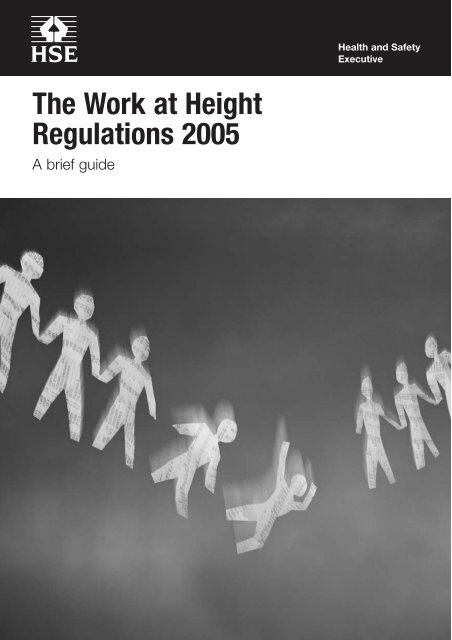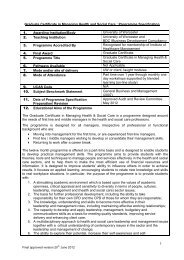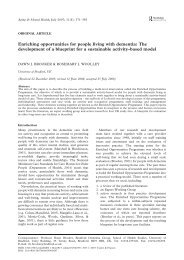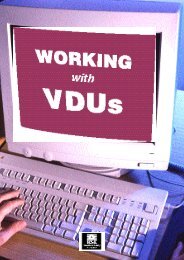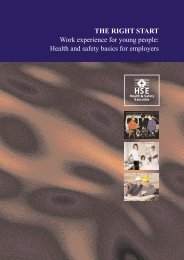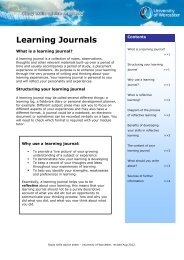The Work at Height Regulations 2005: A Brief Guide - Staffcentral
The Work at Height Regulations 2005: A Brief Guide - Staffcentral
The Work at Height Regulations 2005: A Brief Guide - Staffcentral
Create successful ePaper yourself
Turn your PDF publications into a flip-book with our unique Google optimized e-Paper software.
Off work sick and worried about your job? Steps you can take to help your return to workHealth and SafetyExecutive<strong>The</strong> <strong>Work</strong> <strong>at</strong> <strong>Height</strong>Regul<strong>at</strong>ions <strong>2005</strong>A brief guide1
<strong>The</strong> <strong>Work</strong> <strong>at</strong> <strong>Height</strong> Regul<strong>at</strong>ions <strong>2005</strong>In 2003/04 falls from height accounted for 67 f<strong>at</strong>al accidents <strong>at</strong> workand nearly 4000 major injuries. <strong>The</strong>y remain the single biggest causeof workplace de<strong>at</strong>hs and one of the main causes of major injury.This leaflet is written for employers, the self-employed and anyone whoworks <strong>at</strong> height. It tells you wh<strong>at</strong> you need to do to comply with the<strong>Work</strong> <strong>at</strong> <strong>Height</strong> Regul<strong>at</strong>ions <strong>2005</strong>. <strong>The</strong> Regul<strong>at</strong>ions apply to all work <strong>at</strong>height where there is a risk of a fall liable to cause personal injury.2
<strong>The</strong> <strong>Work</strong> <strong>at</strong> <strong>Height</strong> Regul<strong>at</strong>ions <strong>2005</strong>Using this inform<strong>at</strong>ion1 This leaflet summarises wh<strong>at</strong> you need to do to comply with the <strong>Work</strong> <strong>at</strong> <strong>Height</strong> Regul<strong>at</strong>ions<strong>2005</strong>. Some industry/trade associ<strong>at</strong>ions may have produced more detailed guidance about working<strong>at</strong> height. You can also find more inform<strong>at</strong>ion on the HSE website.2 It has been written so th<strong>at</strong> in most cases it can be used without access to the Regul<strong>at</strong>ions.However, it may be useful to have the Regul<strong>at</strong>ions to hand if you require more inform<strong>at</strong>ion.Why are these rules important?3 <strong>The</strong>se Regul<strong>at</strong>ions have been made to prevent the de<strong>at</strong>hs and injuries caused each year by falls<strong>at</strong> work.4 <strong>The</strong>y replace all the earlier regul<strong>at</strong>ions about working <strong>at</strong> height. <strong>The</strong> <strong>Work</strong> <strong>at</strong> <strong>Height</strong> Regul<strong>at</strong>ions<strong>2005</strong> consolid<strong>at</strong>e previous legisl<strong>at</strong>ion on working <strong>at</strong> height and implement European CouncilDirective 2001/45/EC concerning minimum safety and health requirements for the use of equipmentfor work <strong>at</strong> height (the Temporary <strong>Work</strong> <strong>at</strong> <strong>Height</strong> Directive).Wh<strong>at</strong> is ‘work <strong>at</strong> height’?Regul<strong>at</strong>ion 25 A place is ‘<strong>at</strong> height’ if (unless these Regul<strong>at</strong>ions are followed) a person could be injured fallingfrom it, even if it is <strong>at</strong> or below ground level.6 ‘<strong>Work</strong>’ includes moving around <strong>at</strong> a place of work (except by a staircase in a permanent workplace)but not travel to or from a place of work. For instance, a sales assistant on a stepladder would be working<strong>at</strong> height, but we would not be inclined to apply the Regul<strong>at</strong>ions to a mounted police officer on p<strong>at</strong>rol.3
<strong>The</strong> <strong>Work</strong> <strong>at</strong> <strong>Height</strong> Regul<strong>at</strong>ions <strong>2005</strong>Wh<strong>at</strong> do the Schedules to the Regul<strong>at</strong>ions cover?7 <strong>The</strong>y cover the detailed requirements for: Schedule■ existing places of work and means of access for work <strong>at</strong> height 1■ collective fall prevention (eg guard rails and toe boards) 2■ working pl<strong>at</strong>forms 3■ collective fall arrest (eg nets, airbags etc) 4■ personal fall protection (eg work restraints, work positioning, fall arrest and rope access) 5■ ladders and step ladders 6■ inspection reports (for working pl<strong>at</strong>forms in construction only) 7■ revoc<strong>at</strong>ions 8Do the rules apply to you?Regul<strong>at</strong>ions 3 and 148 <strong>The</strong> <strong>Work</strong> <strong>at</strong> <strong>Height</strong> Regul<strong>at</strong>ions <strong>2005</strong> apply to all work <strong>at</strong> height where there is a risk of a fallliable to cause personal injury. <strong>The</strong>y place duties on employers, the self-employed, and any personwho controls the work of others (eg facilities managers or building owners who may contract othersto work <strong>at</strong> height) to the extent they control the work.9 <strong>The</strong> Regul<strong>at</strong>ions do not apply to the provision of paid instruction or leadership in caving orclimbing by way of sport, recre<strong>at</strong>ion, team building or similar activities.10 If you are an employee or working under someone else’s control, regul<strong>at</strong>ion 14 says you must:■■report any safety hazard to them;use the equipment supplied (including safety devices) properly, following any training andinstructions (unless you think th<strong>at</strong> would be unsafe, in which case you should seek furtherinstructions before continuing).4
<strong>The</strong> <strong>Work</strong> <strong>at</strong> <strong>Height</strong> Regul<strong>at</strong>ions <strong>2005</strong>Special casesRegul<strong>at</strong>ions 3, 15 and 16 and Schedule 211 In certain cases the regul<strong>at</strong>ions can apply outside Gre<strong>at</strong> Britain. (For details see regul<strong>at</strong>ion 3(1).)12 <strong>The</strong>re are some exemptions for shipping, offshore install<strong>at</strong>ions, and docks. (For details seeregul<strong>at</strong>ions 3(4) – 3(6) and 16.) People and organis<strong>at</strong>ions acting in the interests of n<strong>at</strong>ional securitymay be exempted by the Secretary of St<strong>at</strong>e for Defence.13 You may ask the Health and Safety Executive (HSE) to exempt certain people, premises, equipment,or activity from some of the regul<strong>at</strong>ions rel<strong>at</strong>ing to guard rails and the like, but you will have to show th<strong>at</strong>there is no risk to anyone’s health or safety. (For details see regul<strong>at</strong>ion 15 and Schedule 2.)Wh<strong>at</strong> you must you do as an employerOverriding principleRegul<strong>at</strong>ion 6(3)14 You must do all th<strong>at</strong> is reasonably practicable to prevent anyone falling.<strong>The</strong> Regul<strong>at</strong>ions hierarchy15 <strong>The</strong> Regul<strong>at</strong>ions set out a simple hierarchy for managing and selecting equipment for work<strong>at</strong> height.Dutyholders must:■avoid work <strong>at</strong> height where they can;■use work equipment or other measures to prevent fallswhere they cannot avoid working <strong>at</strong> height; and■where they cannot elimin<strong>at</strong>e the risk of a fall, use work equipment or othermeasures to minimise the distance and consequences of a fall should one occur.5
<strong>The</strong> <strong>Work</strong> <strong>at</strong> <strong>Height</strong> Regul<strong>at</strong>ions <strong>2005</strong>Duty holders’ responsibilities16 <strong>The</strong> Regul<strong>at</strong>ions require duty holders to ensure:■■■■■■■all work <strong>at</strong> height is properly planned and organised;all work <strong>at</strong> height takes account of we<strong>at</strong>her conditions th<strong>at</strong> could endanger health and safety;those involved in work <strong>at</strong> height are trained and competent;the place where work <strong>at</strong> height is done is safe;equipment for work <strong>at</strong> height is appropri<strong>at</strong>ely inspected;the risks from fragile surfaces are properly controlled; andthe risks from falling objects are properly controlled.PlanningRegul<strong>at</strong>ions 4 and 6(1, 2)17 You must:■■■■ensure th<strong>at</strong> no work is done <strong>at</strong> height if it is safe and reasonably practicable to do it other than <strong>at</strong> height;ensure th<strong>at</strong> the work is properly planned, appropri<strong>at</strong>ely supervised, and carried out in as safe away as is reasonably practicable;plan for emergencies and rescue;take account of the risk assessment carried out under regul<strong>at</strong>ion 3 of the Management of Healthand Safety <strong>at</strong> <strong>Work</strong> Regul<strong>at</strong>ions.We<strong>at</strong>herRegul<strong>at</strong>ion 4(3, 4)18 You must ensure th<strong>at</strong> the work is postponed while we<strong>at</strong>her conditions endanger health or safety(but this does not apply to emergency services acting in an emergency).Staff trainingRegul<strong>at</strong>ions 5 and 6(5)(b)19 You must ensure th<strong>at</strong> everyone involved in the work is competent (or, if being trained, issupervised by a competent person). This includes involvement in organis<strong>at</strong>ion, planning, supervision,and the supply and maintenance of equipment.6
<strong>The</strong> <strong>Work</strong> <strong>at</strong> <strong>Height</strong> Regul<strong>at</strong>ions <strong>2005</strong>20 Where other precautions do not entirely elimin<strong>at</strong>e the risk of a fall occurring, you must (as faras it is reasonably practicable to do so) train those who will be working <strong>at</strong> height how to avoidfalling, and how to avoid or minimise injury to themselves should they fall.<strong>The</strong> place where work is doneRegul<strong>at</strong>ion 6(4)21 You must ensure th<strong>at</strong> the place where work is done <strong>at</strong> height (including the means of access) issafe and has fe<strong>at</strong>ures to prevent a fall, unless this would mean th<strong>at</strong> it is not reasonably practicablefor the worker to carry out the work safely (taking into account the demands of the task, equipmentand working environment). Detailed safety requirements about where work is done <strong>at</strong> height are setout in Schedule 1.Equipment, temporary structures, and safety fe<strong>at</strong>uresRegul<strong>at</strong>ions 6(4)(b), 6(5)(a, b), 7, 8 and 1222 If you rely on the exception in paragraph 21 above,you must provide equipment for preventing(as far as is reasonably practicable) a fall occurring.23 If the precautions in paragraphs 21 and 22 do not entirely elimin<strong>at</strong>e the risk of a fall occurring,you must do all th<strong>at</strong> is reasonably practicable to minimise the distance and effect of a fall.24 When selecting equipment for work <strong>at</strong> height you must:■■■use the most suitable equipment;give collective protection measures (eg guard rails) priority over personal protection measures (egsafety harnesses);take account of:- the working conditions; and- risks to the safety of all those <strong>at</strong> the place where the work equipment is to be used.25 You must ensure th<strong>at</strong> all equipment, temporary structures (eg scaffolding), and safety fe<strong>at</strong>urescomply with the detailed requirements of Schedules 2 to 6.7
<strong>The</strong> <strong>Work</strong> <strong>at</strong> <strong>Height</strong> Regul<strong>at</strong>ions <strong>2005</strong>InspectionsRegul<strong>at</strong>ions 12 and 1326 ‘Inspection’ is defined by regul<strong>at</strong>ion 12(10) as ‘such visual or more rigorous inspection by acompetent person as is appropri<strong>at</strong>e for safety purposes … (including) any testing appropri<strong>at</strong>e forthose purposes’.27 You must ensure (as far as it is reasonably practicable to do so) th<strong>at</strong> each individual place <strong>at</strong>which work is to be done <strong>at</strong> height is checked on every occasion before th<strong>at</strong> place is used. Thisinvolves checking the surface and every parapet, permanent rail etc.28 You must ensure th<strong>at</strong> any item of a type mentioned in Schedules 2 to 6 is inspected:■■after it is assembled or installed (or after it has been assembled and installed if both are required),if its safety depends on how it is assembled or installed;as often as is necessary to ensure safety, and in particular to make sure th<strong>at</strong> any deterior<strong>at</strong>ioncan be detected and remedied in good time.29 You must ensure th<strong>at</strong> before you use any equipment which has come from another business,and before any equipment leaves your business, it is accompanied by an indic<strong>at</strong>ion (clear toeveryone involved) th<strong>at</strong> the last inspection required by these regul<strong>at</strong>ions has been carried out.Note: This does not apply to lifting equipment governed by regul<strong>at</strong>ion 9(4) of the Lifting Equipmentand Lifting Oper<strong>at</strong>ions Regul<strong>at</strong>ions 1998, but since th<strong>at</strong> rule is similar to this one there is littlepractical difference.30 You must ensure th<strong>at</strong> any pl<strong>at</strong>form used for (or for access to) construction work and from whicha person could fall more than 2 m is inspected in place before use (and not more than seven daysbefore use). Where it is a mobile pl<strong>at</strong>form, inspection <strong>at</strong> the site is sufficient without re-inspectionevery time it is moved.Notes: ‘Construction work’ is defined in detail in regul<strong>at</strong>ion 2(1) of the Construction (Health, Safetyand Welfare) Regul<strong>at</strong>ions 1996 but broadly means ‘the carrying out of any building, civil engineeringor engineering construction work’.‘Pl<strong>at</strong>form’ is widely defined by regul<strong>at</strong>ion 2 to include areas like gangways and stairways.8
<strong>The</strong> <strong>Work</strong> <strong>at</strong> <strong>Height</strong> Regul<strong>at</strong>ions <strong>2005</strong>31 You must ensure th<strong>at</strong> the person inspecting a pl<strong>at</strong>form (as required in paragraph 30):■ prepares a report before going off duty, giving the details listed in Schedule 7;■ gives the report (or a copy) within 24 hours of completing the inspection to the person for whomthe inspection was done (eg you or your site manager).32 You must keep the report of a pl<strong>at</strong>form inspection made under the instructions given inparagraphs 30 and 31:■■<strong>at</strong> the construction site until the work is completed;then <strong>at</strong> an office of yours for another three months.33 ‘Keeping’ a report means keeping it (or a copy) safe from loss and unauthorised interference,and so th<strong>at</strong> a printed copy can be supplied when required.34 You must keep all other records of inspection until the next inspection has been carried out.35 Paragraphs 31 to 33 do not apply to lifting equipment governed by the similar rules imposed byregul<strong>at</strong>ions 9 and 10 of the Lifting Equipment and Lifting Oper<strong>at</strong>ions Regul<strong>at</strong>ions 1998.Fragile surfacesRegul<strong>at</strong>ion 936 You must ensure th<strong>at</strong> no one working under your control goes onto or near a fragile surfaceunless th<strong>at</strong> is the only reasonably practicable way for the worker to carry out the work safely, havingregard to the demands of the task, equipment, or working environment.37 If anyone does work on or near a fragile surface you must:■■ensure (as far as it is reasonably practicable to do so) th<strong>at</strong> suitable pl<strong>at</strong>forms, coverings, guardrails, and the like are provided (and used) to minimise the risk;do all th<strong>at</strong> is reasonably practicable, if any risk of a fall remains, to minimise the distance andeffect of a fall.38 If anyone working under your control may go onto or near a fragile surface, you must do all th<strong>at</strong>is reasonably practicable to make them aware of the danger, preferably by prominent warningnotices fixed <strong>at</strong> the approaches to the danger zone.9
<strong>The</strong> <strong>Work</strong> <strong>at</strong> <strong>Height</strong> Regul<strong>at</strong>ions <strong>2005</strong>Falling objectsRegul<strong>at</strong>ions 10 and 1139 Where it is necessary to prevent injury, you must do all th<strong>at</strong> is reasonably practicable to preventanything falling.40 If it not reasonably practicable, you must ensure th<strong>at</strong> no one is injured by anything falling.41 You must ensure th<strong>at</strong> nothing is:■■thrown or tipped from height if it is likely to injure anyone;stored in such a way th<strong>at</strong> its movement is likely to injure anyone.42 If the workplace contains an area in which there is a risk of someone being struck by a fallingobject or person, you must ensure th<strong>at</strong> the area is clearly indic<strong>at</strong>ed and th<strong>at</strong> (as far as reasonablypracticable) unauthorised people are unable to reach it.10
<strong>The</strong> <strong>Work</strong> <strong>at</strong> <strong>Height</strong> Regul<strong>at</strong>ions <strong>2005</strong>Further readingIf in doubt, contact your local HSE office (the address is in the phone book). <strong>The</strong> staff there can referyou to the appropri<strong>at</strong>e inspector or the environmental health officer <strong>at</strong> your local authority.Legisl<strong>at</strong>ion<strong>Work</strong> <strong>at</strong> <strong>Height</strong> Regul<strong>at</strong>ions <strong>2005</strong> SI <strong>2005</strong>/735 <strong>The</strong> St<strong>at</strong>ionery Office <strong>2005</strong>(Available online <strong>at</strong>: www.hmso.gov.uk/si/si<strong>2005</strong>0735.htm)Management of Health and Safety <strong>at</strong> <strong>Work</strong> Regul<strong>at</strong>ions 1999 SI 1999/3242<strong>The</strong> St<strong>at</strong>ionery Office 1999 ISBN 0 11 085625 2Lifting Equipment and Lifting Oper<strong>at</strong>ions Regul<strong>at</strong>ions 1998 SI 1998/2307<strong>The</strong> St<strong>at</strong>ionery Office 1998 ISBN 0 11 079598 9Construction (Health, Safety and Welfare) Regul<strong>at</strong>ions 1996 SI 1996/1592<strong>The</strong> St<strong>at</strong>ionery Office 1996 ISBN 0 11 035904 6Useful websiteHSE’s Falls from height website: www.hse.gov.uk/falls11
Health and SafetyExecutiveFurther inform<strong>at</strong>ionHSE priced and free public<strong>at</strong>ions are available by mail order from HSE Books,PO Box 1999, Sudbury, Suffolk CO10 2WA Tel: 01787 881165 Fax: 01787 313995Website: www.hsebooks.co.uk (HSE priced public<strong>at</strong>ions are also available from bookshopsand free leaflets can be downloaded from HSE’s website: www.hse.gov.uk.)For inform<strong>at</strong>ion about health and safety ring HSE's Infoline Tel: 0845 345 0055Fax: 0845 408 9566 email: hseinform<strong>at</strong>ionservices@n<strong>at</strong>brit.com or write to HSE Inform<strong>at</strong>ion Services,Caerphilly Business Park, Caerphilly CF83 3GG.<strong>The</strong> St<strong>at</strong>ionery Office public<strong>at</strong>ions are available from <strong>The</strong> St<strong>at</strong>ionery Office,PO Box 29, Norwich NR3 1GN Tel: 0870 600 5522 Fax: 0870 600 5533e-mail: customer.services@tso.co.uk Website: www.tso.co.uk(<strong>The</strong>y are also available from bookshops.)This guidance is issued by the Health and Safety Executive. Following the guidance is not compulsoryand you are free to take other action. But if you do follow the guidance you will normally be doingenough to comply with the law. Health and safety inspectors seek to secure compliance with the lawand may refer to this guidance as illustr<strong>at</strong>ing good practice.This leaflet is available in priced packs of 10 from HSE Books, ISBN 0 7176 2976 7.Single free copies are also available from HSE Books.© Crown copyright This public<strong>at</strong>ion may be freely reproduced, except for advertising, endorsementor commercial purposes. First published 04/05. Please acknowledge the source as HSE.INDG401 04/05 C1000Printed and published by the Health and Safety Executive


